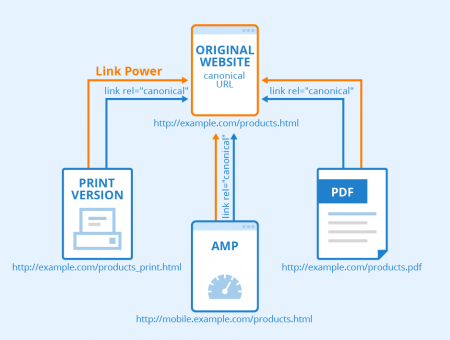Definition

A canonical link (also called canonical tag, canonical URL or URL canonicalization) is included in the HTML code of a webpage to indicate the original source of content. This markup is used to address SEO problems with duplicate content which arise when different pages with different URLs contain identical or nearly identical content. This duplicate content problem can arise in a number of ways, often without the website administrator’s knowledge, including when:
- a webpage is accessible with or without “www” prefix in its URL
- a webpage is accessible via “HTTP” and “HTTPS” protocols
- there are multiple versions of a webpage using different URLs (for example a print version or when using sort categories etc.)
For SEO purposes, the canonical link shows Google and other search engines which URL corresponds to the original source of content and should be shown in search results. It is added as a meta tag to every URL version of a given webpage and indicates the canonical URL. Note that the link is only a recommendation; Google can ignore it if it is used inappropriately.
Ideally, every page of a site should contain a canonical link to avoid the risk of duplicate content in the future.
Correct use of canonical links
A canonical link is added to the <head> of a webpage to indicate the canonical URL version. For example, if the webpages
http://www.example.com/product.html
and
http://www.example.com/product_print.html
(the print version)
refer to the same content and you want to indicate to search engines that the first one is the canonical URL version, you can add the following link to the print version page:
<link rel="canonical" href="http://www.example.com/product.html" />
Alternatively, you can include the link in the HTTP response header.
When using canonical tags, be aware that both pages must contain (almost) the same content. This means that text and images on both pages should be largely identical. If the pages merely relate to the same topic but don’t contain the same content, this can result in search engines ignoring the link – or even in Google disregarding all such links on the website in future. For instance, this can happen when multiple canonical links are set on one page.
Canonical Tag Checker
Check if you set your canonical tags correctly
You should also ensure that the link’s target page actually exists, and does not contain a “noindex” Robots meta tag. In addition, it should, of course, be the page that you want Google to display in search results.
Furthermore, this kind of link cannot be used for paginated webpages. This means that you must not add a canonical link to pages 2, 3, etc. which points to page 1 of a pagination. These pages are often thematically related, but they aren’t identical content. If canonical links were used in this case, only the first page would be shown in Google’s search results, while all the other pages would be ignored. An acceptable SEO workaround would be to create an overview page with the content of all paginated pages and to use the canonical link to indicate that this page should appear in search results.
Another aspect to keep in mind when using Canonical Links is that the link is in the head and not in the body area of the page.
To make sure that you don’t overlook any of these requirements, we have put together a short checklist of the key points:
- Is the content of both pages (almost) identical?
- Is there only one canonical link on each page?
- Does the target page actually exist?
- Are there ‘noindex’ meta tags on the target page?
- Is the canonical page the one you want to appear in search results?
- Has an overview page been created for paginated pages?
- Is the link in the head, rather than the body of the HTML Code?
Importance of “self-canonicalization”
This is the practice of adding a canonical tag to a page that points to its own URL as the canonical version. While it may seem redundant at first, self-canonicalization is critical for several reasons:
- Preventing unintentional duplication: Even if you believe that there are no duplicate versions of a page, unforeseen circumstances or site changes could lead to the creation of duplicate content in the future. By self-canonicalizing, you ensure that the original page retains its authority and is recognized by search engines as the primary source.
- Protection from scrapers: If another site scrapes and republishes your content without changing the canonical tag, the scraped content will point back to your original page as the canonical version, helping to maintain SEO value.
SEO advantages of canonical tags
The advantage of a canonical tag is that it can be added directly to the page in question – you don’t need access rights to the server configuration, as you would for server-side redirects. Further, you can use the tag to specify a standard page without needing to redirect to another URL.
In addition, when you use a canonical link Google no longer splits the ranking across the individual URLs, but bundles it, improving the canonical page’s ranking in search results. All this makes canonical links an important tool for SEO which is supported by search engines like Google, Yahoo, and Bing.
Related links
